Pumpkin is truly one of the most decorative ornaments of any plot. It is impossible not to notice it. In addition to its external attractiveness, it has many useful properties and is used to prepare a variety of tasty and nutritious dishes.
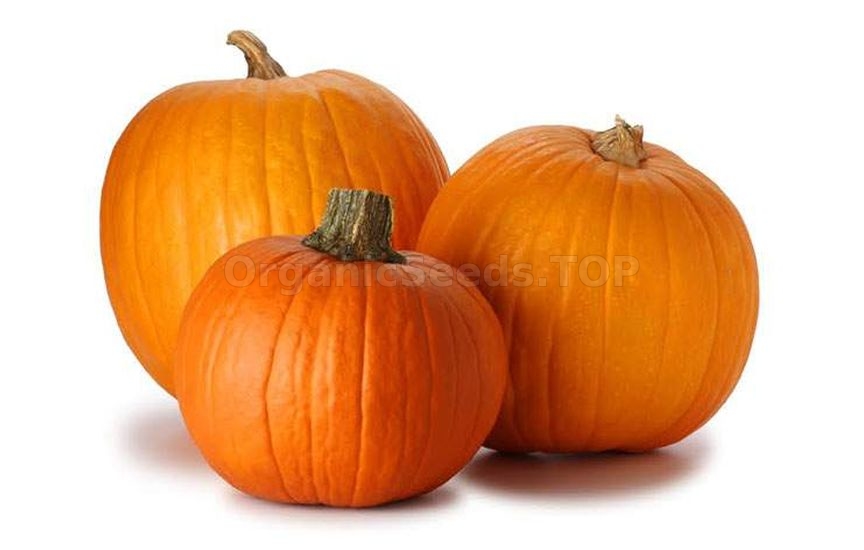
Common pumpkin belongs to the genus of annual herbaceous plants, belongs to the Pumpkin family. All about pumpkin, main features:
Fruit - a spherical pumpkin, covered with a hard, smooth, ribbed skin.
Pulp - loose, fleshy, orange shades.
Taste - moderately sweet.
Flowers - large, yellow or white, located singly or in bunches. The corolla is in the form of a funnel, the length of which is 5-7 cm, the width is 6-7 cm. Flowers are unisexual. Male flowers are located on long peduncles, female flowers - on short ones. Pollination is cross.
Seeds are large, flat, from 1 to 3 cm in size. They are located under the pulp, in the seed space. On the outside they are covered with a woody shell of white with a yellowish tint or cream color, on the inside - a gray-green film.
Stem - creeping type, pentagonal, pubescent, up to 7-8 m long.
Leaves - alternate, large (up to 25 cm long), hard, five-lobed type, heart-shaped, covered with hard hairs. In the axils of the leaves there are tendrils in the form of a spiral.
The root system of the pumpkin is a taproot, strong branching.
Is pumpkin a berry or a fruit, or a vegetable? There is still no exact definition of what a pumpkin is. The plant can be classified as a fruit due to its juiciness. Botanists cannot decide whether pumpkin is a vegetable or a berry. For a gardener and a cook, it is more common to call it a vegetable. From a scientific point of view, it is a berry.
Types and varieties of pumpkin
Pumpkins have a wide variety of types, varieties, shapes, colors and sizes. There are over 50 varieties of pumpkin. The color range varies from dark green to deep orange, up to red. There are varieties of a gray-blue hue. There is a giant among pumpkins - the Atlantic Giant variety. A representative of this variety can weigh about 80 kg on average. The most gigantic fruit, grown by American farmer Chris Stevens, reached a weight of 821.2 kg. In many countries, in October, on the eve of Halloween, a competition "The Biggest Pumpkin" is held.
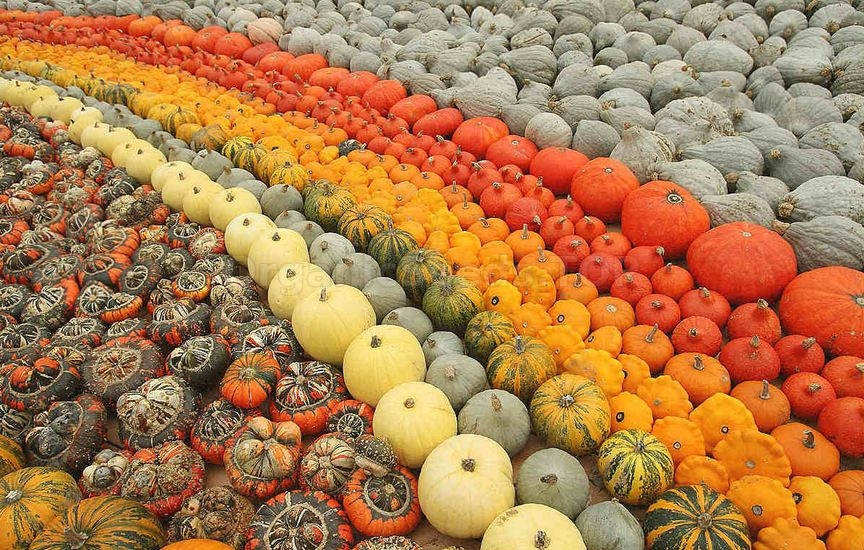
Among the miniature varieties, the smallest fruits are produced by Jack be Little. A pumpkin the size of a child's fist reaches a mass of only about 200 g. This variety can even be grown on a balcony. There is a variety of pumpkin crossed with a melon. The variety is distinguished not only by the sweetness of the pulp, but also by a pleasant aroma.
According to their purpose, pumpkins are classified into 3 types:
- decorative - for decorating walls and fences;
- fodder - large pumpkins for animal feeding;
- common - for humans.
- fodder and common types do not have a clear distinction. Both varieties can be used for human and animal feeding. This depends on the amount of the harvest, the taste of the fruits. Varieties of common pumpkins, in turn, can be classified as nutmeg, hard-skinned and large-fruited.
Butternut squash
Butternut squash is the most delicious. Its sweet, aromatic flesh can be eaten even raw. Characteristic features of nutmeg varieties are late ripening and heat-loving. Seeds are sown in April, and seedlings are planted in early June.
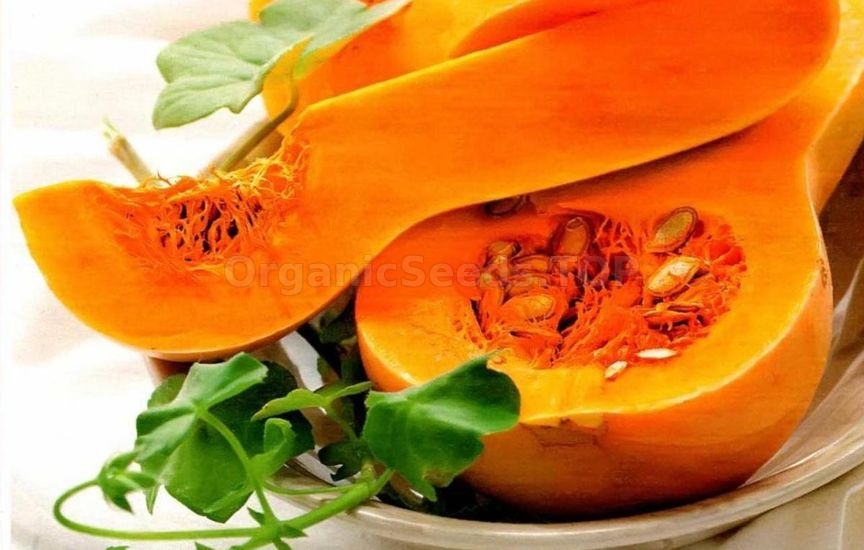 Distinctive features:
Distinctive features:
- green striped or yellow-beige rind;
- pentagonal stalk, widening downwards;
- light orange flesh.
Hard-skinned pumpkin
Hard-skinned pumpkin is the most common variety. It has the most delicious seeds. It is distinguished by its early ripening period: late August – early September. There are two varieties: gymnospermous, spaghetti squash.
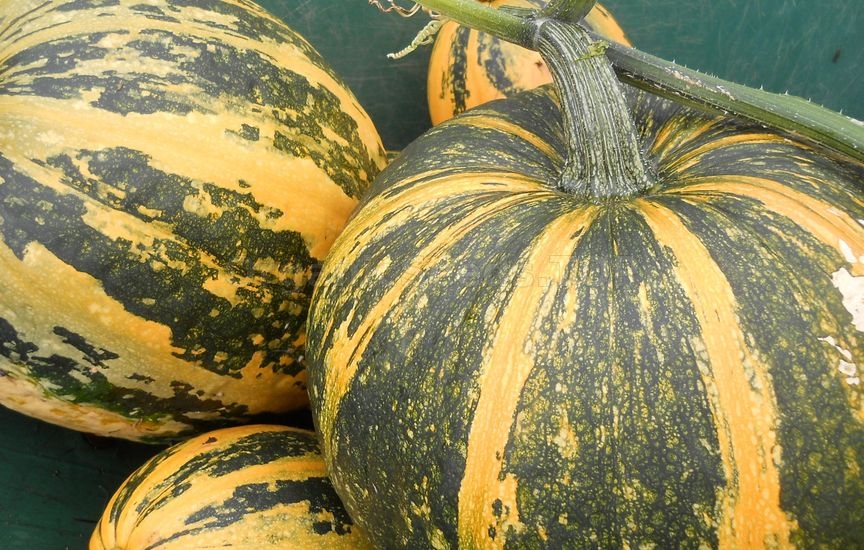 Main features:
Main features:
- very hard woody bark of a pale or brownish-orange color, with dark stripes;
- the stalk has distinct grooves;
- pentagon-shaped leaves;
- hard, ribbed stem with prickly pubescence;
- weight varies from 1 to 20 kg.
Large-fruited pumpkin
Large-fruited pumpkin has loose pulp with a fibrous structure, a very thick crust. A distinctive feature of the plant is the longest shelf life, cold resistance.
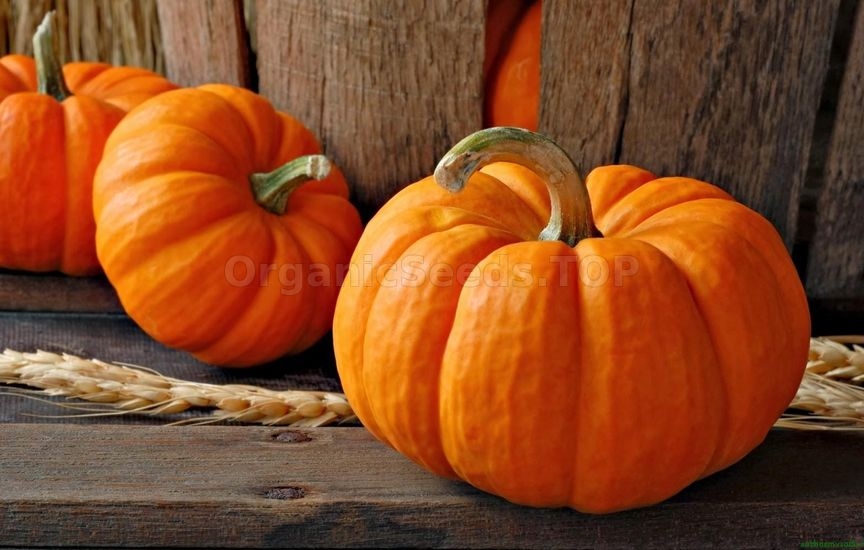 Main characteristics of varieties:
Main characteristics of varieties:
- very sweet pulp, sugar content reaches 15%;
- stem has no grooves, rounded;
- fruit stalk in the form of a cylinder;
- leaves are kidney-shaped.
Growing features
Pumpkin loves light, warmth and moisture. Flowering period - June, July. Fruit ripening time - August, September. Favorable climate for the plant is subtropical or moderate. Light frosts and drying out of the soil are detrimental to it. The soil before planting should be warmed up to + 14 degrees. The plant responds very well to the introduction of organic fertilizers. You need to be more careful with chemical mineral nutrient complexes. On the eve of harvesting, they can negatively affect the taste.
Growing pumpkin largely depends on the temperature regime. Depending on their resistance to cold, there are varieties for moderate climates, northern latitudes, and heat-loving varieties. The plant is planted in open ground, a greenhouse, and also with the help of a long seedling period.
Pumpkin properties
Despite the fact that it is still unclear whether pumpkin is a vegetable or a fruit, there is no doubt about its invaluable health benefits.
Nutritional value
This beautiful and tasty plant has a high nutritional value, as it contains a record amount of vitamins, macro- and microelements. Pumpkin is a dietary product, as its caloric content per 100 g is only 22 kcal. It consists of 91.8% water. Contains 4.4% carbohydrates, 0.1% fats, 0.1% organic acids, 2 g dietary fiber, 1 g protein, 0.6 g ash, 0.2 g starch, 4.2 g mono- and disaccharides.
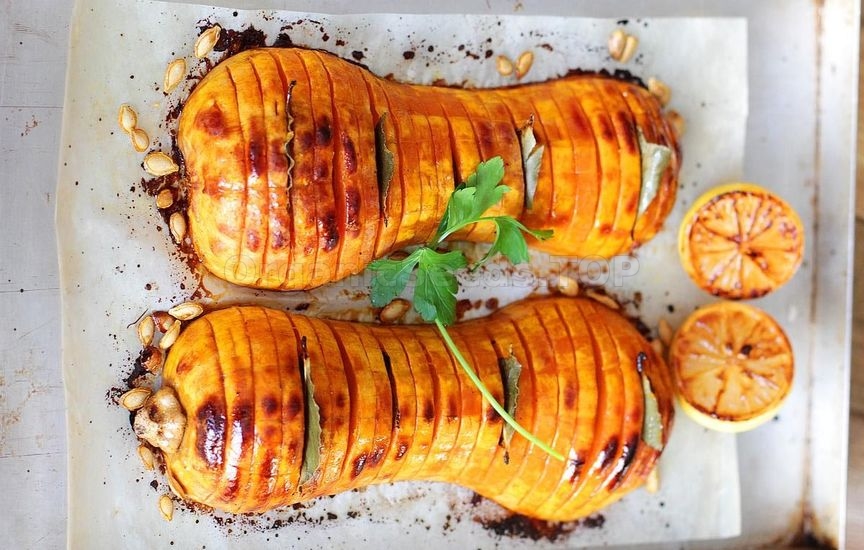 The list of nutrients contained in 100 g of pumpkin is truly impressive:
The list of nutrients contained in 100 g of pumpkin is truly impressive:
- vitamins: B9, B1, B2, B5, B6, B17, C, PP, E, A, beta Carotene, niacin;
- microelements: copper, fluorine, zinc, iron, manganese, iodine, cobalt;
- macroelements: potassium, phosphorus, calcium, chlorine, sulfur, magnesium, sodium.
- The rich chemical composition provides numerous useful properties of pumpkin.
Healing properties
What is pumpkin useful for? It is considered one of the best means for restoring and maintaining the health of the visual organs, due to the content of vitamins A, B6, B2, E, and zinc. The high content of carotenoids in the pulp protects the retina from destruction, neutralizes the effects of free radicals. Vitamin A, necessary for visual acuity, is absorbed better due to the content of zinc in the composition. Riboflavin (B2) helps improve light and color perception.
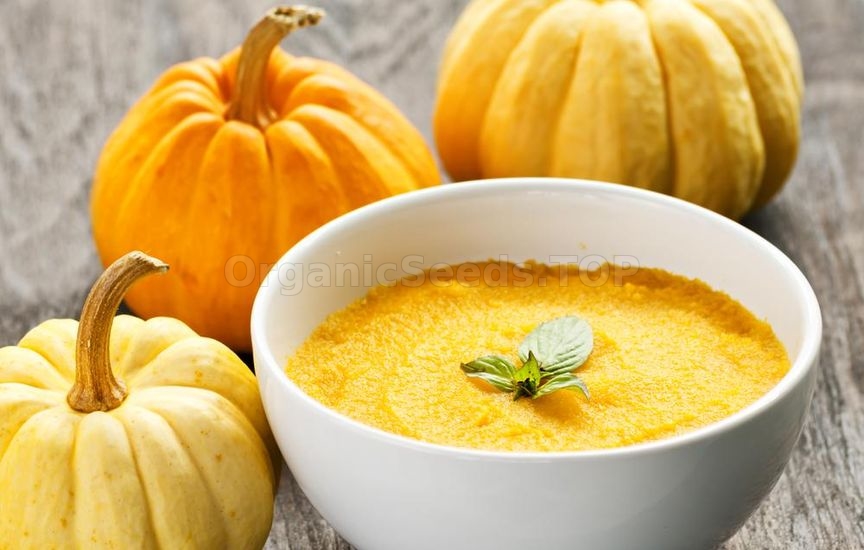
Pumpkin has surpassed carrots in terms of B-carotene content, exceeding its value by 5 times. Carotene together with vitamin E prevents the risk of cancer, strengthens the immune system, protects against viruses and bacteria.
Folic acid in the pulp activates the synthesis of erythrocytes, red blood cells responsible for oxygen transport. The formation of leukocytes, the body's defenders, is stimulated. Rarely occurring vitamin B17 (T) regulates blood clotting, improves platelet formation.
Pumpkin has a therapeutic effect on ulcerative diseases of internal organs. With gastritis, it is good to eat dishes made from pumpkin pulp: porridge, desserts, salads. The plant helps to reduce high acidity of the stomach, as it creates an alkaline environment. The plant relieves heartburn and belching.
The abundance of fiber in pumpkin pulp is useful for cleansing the intestines. Swollen dietary fiber absorbs waste and removes it naturally. To restore healthy intestinal motility, it is enough to eat a piece of boiled pumpkin for dinner.
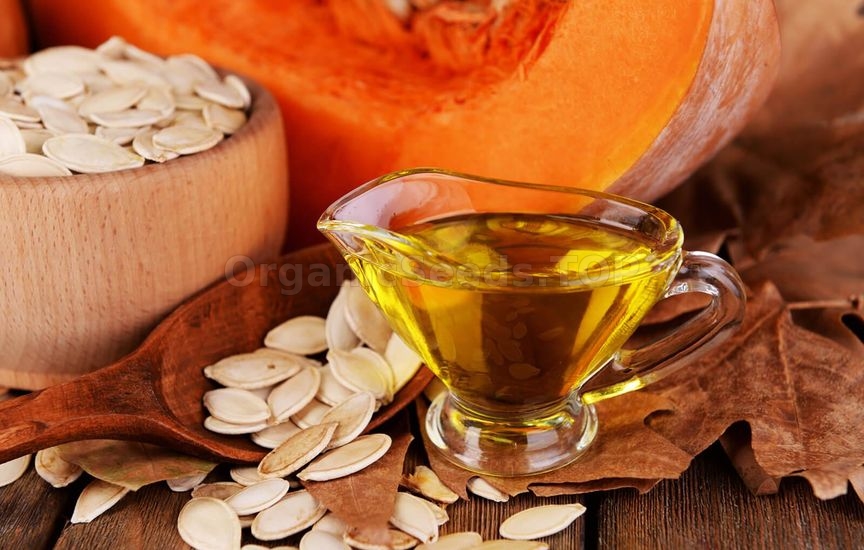
It is useful for a person who wants to lose weight to include pumpkin dishes in their diet. Pumpkin is a source of L-carnitine, which is necessary for normalizing metabolism and breaking down fat. Potassium in the pulp allows you to remove stagnant fluid from the tissues - the cause of body swelling. It also removes excess volume.
What vitamins in pumpkin are necessary for the stronger sex? A man who wants to restore sexual function must eat pumpkin. It contains zinc, which normalizes the activity of the prostate gland and promotes the synthesis of sperm. The presence of vitamin C, B1, B3, B6 and L-carnitine makes it indispensable for increasing endurance, strengthening the immune system, and assimilating fatty acids.
It is useful for a woman suffering from fibrocystic mastopathy to use pumpkin pulp both internally and externally. It is also an excellent preventive measure. Thanks to vitamin E, cell aging slows down, and the skin condition improves. Eating pumpkin helps to alleviate the symptoms of menopause.
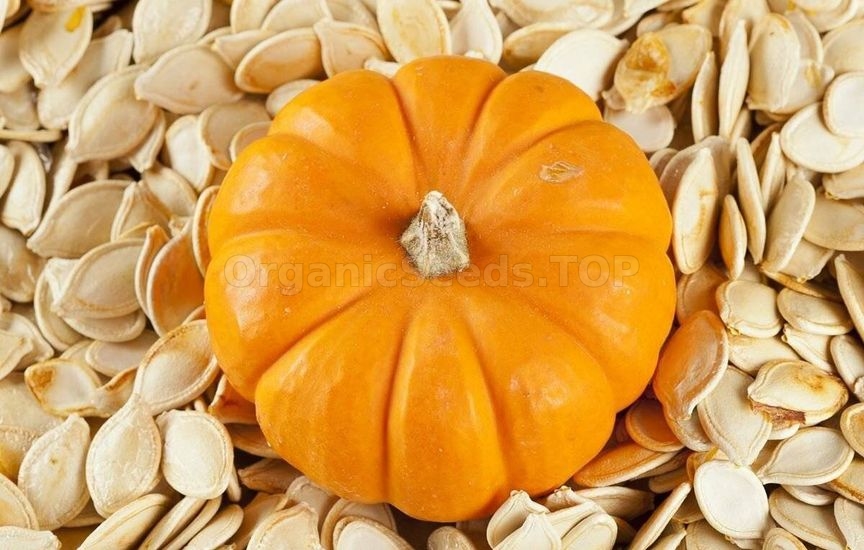
The soft choleretic effect of pumpkin will help after eating heavy food, and also as a preventive measure. 500 g of raw pulp, minced in a meat grinder, mixed with 100 g of olive or sunflower oil. Add 2 tbsp. of warty birch buds to the mixture and leave for a week. The medicinal infusion should be taken 2 tbsp. before meals three times a day.
The plant is an excellent means of cleansing the liver of waste, restoring hepatocytes, activating cell division. For a beneficial effect on the liver, it is enough to spend 1 fasting day on pumpkin. To do this, grate 0.5 kg of raw pulp, divide the resulting mass into 6 portions and eat during the day.
Pumpkin seeds contain unsaturated fatty acids. Arachidonic fatty acid helps with Alzheimer's disease, improves mental abilities, memory, strengthens muscles. The seeds contain a large number of essential amino acids, vitamins, macro- and microelements. The gentle and safe effect of pumpkin seeds against tapeworms is known, especially in children. Pleasant and healthy pumpkin seed oil is used as a food supplement to improve the health of the body.
Contraindications
Pumpkin pulp has almost no contraindications, since it does not cause allergic reactions even in children and the elderly. Warnings about the use of fresh vegetable juice and raw pumpkin pulp apply to people with low stomach acidity, weak digestion, sensitivity to dietary fiber. In severe diabetes, it should also be avoided, since it contains sugar. It should not be included in the diet for gallstone disease due to its choleretic effect.
Pumpkin seeds also have contraindications. In addition to useful substances, they contain saturated fats. In large quantities, they contribute to obesity and provoke vascular diseases in the body.
You may need:
|









